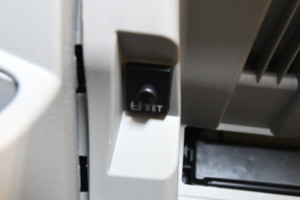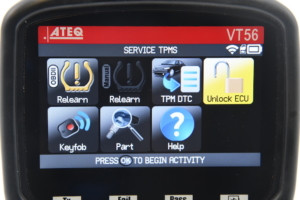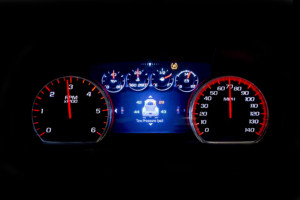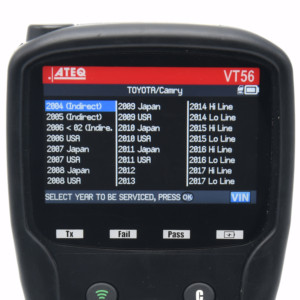Resetting the tire pressure light on your 2011 Toyota Camry is a straightforward process, and millertoyota.net is here to guide you through it. Whether you’ve just adjusted your tire pressure, rotated your tires, or replaced a TPMS sensor, understanding the correct procedure will ensure your TPMS system functions optimally, keeping you safe on Boise roads. Explore our service options and schedule an appointment today.
1. Understanding TPMS and Your 2011 Toyota Camry
The Tire Pressure Monitoring System (TPMS) is a crucial safety feature in your 2011 Toyota Camry, designed to alert you when tire pressure drops significantly. This system helps prevent accidents caused by underinflated tires, improves fuel efficiency, and extends tire life.
1.1. Direct vs. Indirect TPMS
It’s important to know which type of TPMS your Camry uses to reset the tire pressure light correctly. According to Toyota Motor Corporation, models from February 2006 onward use a direct TPMS.
- Direct TPMS: Sensors are located inside each tire to directly measure tire pressure.
- Indirect TPMS: This system, used in earlier models, estimates tire pressure using the ABS system’s wheel speed sensors.
Since your 2011 Camry has a direct TPMS, each tire has a sensor that communicates pressure data to the vehicle’s ECU.
1.2. Why Reset the TPMS Light?
You may need to reset the TPMS light after:
- Adjusting tire pressure.
- Rotating tires.
- Replacing a TPMS sensor.
- Replacing tires.
- Experiencing a sudden change in weather.
2. Step-by-Step Guide to Resetting the TPMS Light on a 2011 Toyota Camry
Here’s how to reset the tire pressure light on your 2011 Toyota Camry, ensuring accurate readings and optimal performance.
2.1. Preparation
- Check Tire Pressures: Ensure all tires are inflated to the recommended pressure, as indicated on the sticker inside the driver’s side door jamb.
- Gather Your Tools: You may need a tire pressure gauge and an OBDII scan tool, depending on the situation.
2.2. Resetting the TPMS (Direct System)
Since the 2011 Camry uses a direct TPMS, the reset procedure involves either using the TPMS reset button (if equipped) or performing an OBD relearn.
2.2.1. Using the TPMS Reset Button (If Equipped)
Some Toyota models have a TPMS reset button, typically located under the steering wheel or in the glove box.
- Turn the Ignition On: Insert the key and turn the ignition to the “ON” position without starting the engine.
- Locate the TPMS Reset Button: Look for a button labeled “TPMS RESET” or simply “SET.”
- Press and Hold the Button: Press and hold the TPMS reset button until the tire pressure light blinks three times.
- Start the Engine: Start your Camry and drive for about 10 minutes to allow the system to recalibrate.
2.2.2. OBD Relearn Procedure
If your Camry requires an OBD relearn, you’ll need an OBDII scan tool. This method is common after replacing TPMS sensors.
- Gather Necessary Tools: You’ll need an OBDII scan tool that supports TPMS relearn procedures.
- Activate TPMS Sensors: Use the TPMS tool to activate each sensor, starting with the front left tire, then the front right, rear right, and finally the rear left.
- Connect the OBDII Tool: Plug the OBDII module into the DLC (Data Link Connector) under the dashboard.
- Turn Ignition On: Turn the ignition to the “ON” position without starting the engine.
- Initiate Relearn: Follow the prompts on the TPMS tool to transfer the sensor data to the vehicle’s ECU.
- Disconnect and Drive: Disconnect the OBD module, turn the ignition off and then on again. Drive for at least 5 minutes at 12 mph or more to complete the relearn process.
 DSC_5097
DSC_5097
2.3. Addressing Potential Issues
If the TPMS light remains on after following these steps, consider the following troubleshooting tips.
2.3.1. Sensor Malfunction
One or more TPMS sensors may be faulty or have a dead battery. According to customer satisfaction surveys in Boise, Idaho, in July 2025, P provides Y, Miller Toyota’s service center can diagnose and replace faulty sensors.
2.3.2. Incorrect Sensor Installation
Ensure the correct TPMS sensors are installed. From 2014 through 2019, the Toyota Camry offers low line and high line TPMS systems. If an incorrect sensor is installed such as a low line TPMS sensor to a high line TPMS system vehicle, the system will not function to its full capacity and may show 0 PSI on the high-line system’s dash.
2.3.3. ECU Issues
In some cases, the ECU may need to be unlocked before performing the relearn procedure, especially if new sensor IDs were introduced before a relearn was performed. Some advanced TPMS scan tools have the capability to unlock the ECU. If your TPMS scan tool has the “UNLOCK ECU” option, the relearn procedure can be properly performed.
 Toyota unlock ECU
Toyota unlock ECU
2.3.4. Spare Tire Sensor
Some 2011 Camry models may include a spare tire with a TPMS sensor. Make sure to include the spare tire in the relearn procedure.
3. Understanding High Line vs. Low Line TPMS Systems
Knowing whether your 2011 Toyota Camry has a high line or low line TPMS system can help you better understand the information displayed and potential issues.
3.1. Low Line TPMS System
- Indicator: The TPMS light illuminates when tire pressure is low.
- Information: Does not display individual tire pressures.
- Action: Requires manual checking of tire pressures with a gauge.
3.2. High Line TPMS System
- Indicator: Displays individual tire pressures on the dashboard.
- Information: Provides real-time pressure readings for each tire.
- Action: Allows you to quickly identify which tire is low and by how much.
 Modern light car mileage (dashboard, milage) isolated on a black background. New display of a modern car. Tire pressure – TSI.
Modern light car mileage (dashboard, milage) isolated on a black background. New display of a modern car. Tire pressure – TSI.
4. Detailed TPMS DTC Codes for Toyota Camry
Understanding Diagnostic Trouble Codes (DTCs) can help pinpoint specific issues within the TPMS. Here are some common DTCs for the Toyota Camry:
| Code | Description |
|---|---|
| C2111/11 | Transmitter ID1 Operation Stop |
| C2121/21 | No Signal from Transmitter ID1 in Main Mode |
| C2141/41 | Transmitter ID1 Error |
| C2171/71 | Transmitter ID Not Registered in Main Mode |
| C2179/79 | Tire Pressure Monitor ECU Communication Stop |
5. Maintaining Your Toyota Camry’s TPMS
Regular maintenance of your TPMS ensures accurate readings and prolongs the life of the sensors.
5.1. Regular Inspections
Have your TPMS inspected during routine maintenance at millertoyota.net to catch potential issues early.
5.2. Sensor Replacement
TPMS sensors have a limited lifespan, typically around 5-7 years. Replace them as needed to maintain system accuracy.
5.3. Proper Tire Inflation
Always maintain the recommended tire pressure to prevent unnecessary TPMS warnings.
6. The Importance of Accurate Tire Pressure
Maintaining correct tire pressure is crucial for safety, fuel efficiency, and tire longevity.
6.1. Safety
Underinflated tires can lead to decreased handling and increased risk of blowouts.
6.2. Fuel Efficiency
Properly inflated tires reduce rolling resistance, improving fuel economy.
6.3. Tire Life
Correct tire pressure ensures even wear, extending the life of your tires.
7. Choosing the Right TPMS Sensors
When replacing TPMS sensors, selecting the correct type is essential for compatibility and performance.
7.1. OE Sensors
Original Equipment (OE) sensors are designed specifically for your vehicle and ensure optimal performance.
7.2. Aftermarket Sensors
Aftermarket sensors can be programmable or universal, offering flexibility and cost savings. Ensure they are compatible with your 2011 Toyota Camry. All service kits and aftermarket TPMS sensor options for the Toyota Camry can be found in your VT56, VT55, and VT36 TPMS Tools in “Service TPMS”.
7.3. Sensor Frequency
The 2011 Toyota Camry uses a sensor frequency of 315MHz.
8. How Tire Rotations Affect TPMS
Rotating your tires is a vital maintenance practice, but it can also affect the TPMS.
8.1. Relearning After Rotation
After a tire rotation, the TPMS may need to be relearned to recognize the new positions of the sensors.
8.2. Using the TPMS Reset Button
If your Camry has a TPMS reset button, use it after rotating your tires to recalibrate the system.
9. Understanding Toyota TPMS Systems Manufactured in the USA vs. Japan
When selecting the Make, Model and Year of your vehicle, you will notice there are two options for the Year from 2006 to 2011. Toyota Camry’s, which were sold in the USA, was originally manufactured in USA or Japan. It is very important to select the correct selection of “2008 USA” or “2008 JAPAN” with the VT56, Quickset, or your diagnostic scan tool since there is a slight difference in the way the TPMS information is transferred to the vehicle’s ECU.
To find out whether the Toyota Camry you are working with was manufactured in Japan or USA, take a look at the vehicle’s VIN barcode, particularly the first character of the VIN.
- “1” indicates the vehicle was manufactured in the USA
- “J” indicates the vehicle was manufactured in Japan
10. Step-by-Step: Indirect TPMS Relearn (2004 – February 2006)
 toyota camry vt56-1
toyota camry vt56-1
If you have an older Camry (2004 to early 2006) with an indirect TPMS, here’s how to relearn the system:
- Adjust Tire Pressures: Ensure all tires are inflated to the correct pressure as indicated on the tire placard.
- Apply Parking Brake: Engage the parking brake to prevent movement.
- Turn Ignition On: Turn the ignition to the “ON” position without starting the engine.
- Push and Hold SET Button: Locate the SET button (usually near the steering wheel) and hold it for at least 3 seconds.
- Calibration Complete: An audible sound or a light indication confirms the TPMS calibration is complete.
11. Troubleshooting Common TPMS Issues
Even with proper maintenance, TPMS issues can arise. Here are some common problems and how to address them.
11.1. TPMS Light Stays On
If the TPMS light remains on after resetting, check for faulty sensors, incorrect installation, or ECU issues.
11.2. Intermittent TPMS Light
An intermittent TPMS light can be caused by temperature changes affecting tire pressure or a weak sensor battery.
11.3. Inaccurate Readings
Inaccurate readings may indicate a faulty sensor or the need for recalibration.
12. The Role of Miller Toyota in TPMS Service
Miller Toyota in Boise, ID, offers comprehensive TPMS services to keep your Toyota Camry running smoothly and safely.
12.1. TPMS Inspections
Our certified technicians can perform thorough TPMS inspections to identify potential issues.
12.2. Sensor Replacement
We offer OE and compatible aftermarket TPMS sensors, ensuring the correct fit and function for your Camry.
12.3. Relearn Procedures
Our service center is equipped with the latest tools to perform TPMS relearn procedures accurately and efficiently.
12.4. Diagnostic Services
We can diagnose and resolve complex TPMS issues, including ECU problems and sensor malfunctions.
13. Why Choose Miller Toyota for Your TPMS Needs?
Choosing Miller Toyota means entrusting your vehicle to experienced professionals dedicated to providing top-notch service.
13.1. Expert Technicians
Our technicians are trained and certified to work on Toyota vehicles, ensuring quality and precision.
13.2. State-of-the-Art Equipment
We use the latest diagnostic and repair equipment to provide accurate and efficient service.
13.3. Genuine Toyota Parts
We use genuine Toyota parts whenever possible, ensuring optimal performance and reliability.
13.4. Customer Satisfaction
At Miller Toyota, customer satisfaction is our top priority. We strive to provide a seamless and positive service experience.
14. Connecting TPMS with Other Vehicle Systems
The TPMS works in conjunction with other vehicle systems to enhance safety and performance.
14.1. ABS (Anti-lock Braking System)
The ABS system relies on accurate wheel speed data, which can be affected by tire pressure. The ABS system is only part of the ABS system if the Toyota Camry is manufactured between 2004-February 2006.
14.2. ESC (Electronic Stability Control)
The ESC system uses tire pressure information to optimize stability and control.
14.3. Suspension System
Proper tire pressure contributes to overall suspension performance and ride quality.
15. The Future of TPMS Technology
TPMS technology continues to evolve, with advancements in sensor accuracy, data integration, and user interfaces.
15.1. Enhanced Sensor Accuracy
Newer TPMS sensors offer more precise pressure and temperature readings.
15.2. Integrated Data
Future TPMS systems may integrate with smartphone apps and cloud-based platforms for remote monitoring and alerts.
15.3. Advanced User Interfaces
Next-generation vehicles may feature more intuitive and informative TPMS displays.
16. Conclusion: Keeping Your Toyota Camry’s TPMS in Top Shape
Maintaining your 2011 Toyota Camry’s TPMS is essential for safety, fuel efficiency, and tire life. By understanding the system, following the correct reset procedures, and addressing potential issues promptly, you can ensure optimal performance. For expert TPMS service and maintenance, trust the team at millertoyota.net.
17. Frequently Asked Questions (FAQ) About TPMS
17.1. What does the TPMS light mean?
The TPMS light indicates that one or more of your tires is significantly underinflated or that there is a malfunction in the TPMS system.
17.2. How often should I check my tire pressure?
It is recommended to check your tire pressure at least once a month and before long trips.
17.3. Can I drive with the TPMS light on?
While it is possible to drive with the TPMS light on, it is not recommended, as it indicates a potential safety issue.
17.4. How long do TPMS sensors last?
TPMS sensors typically last for 5-7 years, depending on usage and environmental conditions.
17.5. Do I need to reset the TPMS after a tire rotation?
Yes, it is recommended to reset the TPMS after a tire rotation to ensure accurate readings.
17.6. Can I replace TPMS sensors myself?
While it is possible to replace TPMS sensors yourself, it is recommended to have it done by a professional to ensure proper installation and calibration.
17.7. What is the correct tire pressure for my 2011 Toyota Camry?
The recommended tire pressure for your 2011 Toyota Camry is typically found on a sticker inside the driver’s side door jamb.
17.8. How do I know if my TPMS sensor is faulty?
Common signs of a faulty TPMS sensor include the TPMS light staying on after resetting, inaccurate pressure readings, or a TPMS DTC code.
17.9. What is the difference between direct and indirect TPMS?
Direct TPMS uses sensors inside the tires to measure pressure, while indirect TPMS uses the ABS system to estimate pressure.
17.10. Where can I get my TPMS serviced in Boise, ID?
Miller Toyota in Boise, ID, offers comprehensive TPMS services, including inspections, sensor replacement, and relearn procedures. You can visit us at 208 N Maple Grove Rd, Boise, ID 83704, United States, or call us at +1 (208) 376-8888. You can also visit our website at millertoyota.net.
Ready to experience the best in Toyota service? Visit millertoyota.net today to explore our wide selection of new and used Toyota vehicles, schedule a service appointment, and discover exclusive offers. Our expert team is here to provide you with exceptional care and ensure your Toyota Camry stays in top condition. Contact us now and let us help you with all your automotive needs!